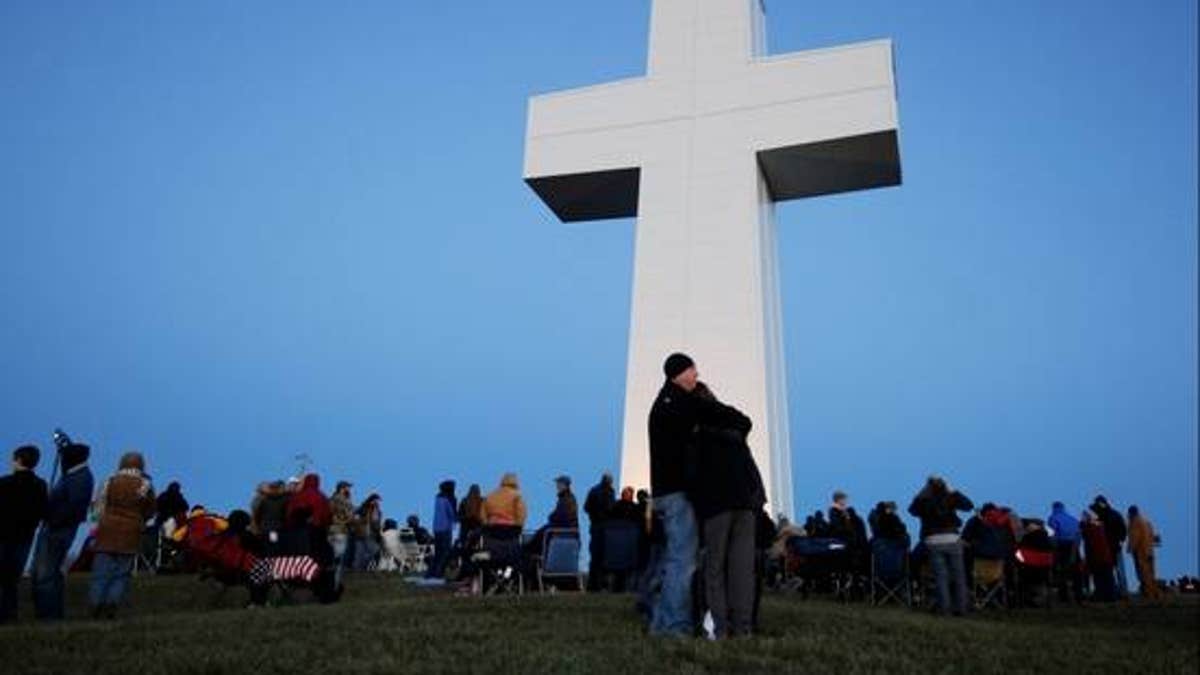
Dec. 22, 2012: Spectators huddle together for warmth before the lighting of the Bald Knob Cross of Peace in Alto Pass, Ill. The lighting ceremony marked the completion of a renovation project that began in 2009. (AP)
The U.S. Supreme Court has rejected a Buffalo Grove atheist's final appeal in his lawsuit challenging the use of state funds to renovate an 11-story cross atop southern Illinois' tallest peak, ending the legal dispute spanning more than two years.
The nation's high court on Tuesday declined without comment to review Robert Sherman's request to hear his case involving the $20,000 grant given in 2008 to the 111-foot-high Bald Knob Cross of Peace near Alto Pass. Lower courts already had ruled that Sherman lacked standing to sue over the grant.
Sherman sued in August 2010, arguing that efforts to repair the cross using state money have "the primary effect of advancing a particular religious sect, namely Christianity." He noted that the grant came from a $5 million pot of money that the state Legislature channeled to the Illinois Department of Commerce and Economic Opportunity.
Sherman insisted that the grant was a legislative earmark — not a discretionary allocation from the executive branch — and therefore violated the First Amendment's prohibition against the establishment of religion.
"This action by the Supreme Court affirms that our nation's court system is a joke," Sherman said in a statement. The high court's "refusal to take my case means that any legislative (body), whether it be Congress, a state legislature or a municipal board, can make blatantly unconstitutional grants to advance religion simply by naming an executive branch agency as a middleman in the transaction.
"What a joke! What a fraud against the taxpayers of this country."
Marcelyn Love, a spokeswoman for the Illinois Department of Commerce and Economic Opportunity, declined to comment.
D.W. Presley, president of the cross' board of directors, called the Supreme Court's decision "not completely surprising," given the atheist's series of legal defeats.
"In the grand scheme of things, while this is sensational news, this was just a small portion of what we've had going on in the last three years. The more important story is seeing the cross restored," Presley said. Sherman "used the legal process to the fullest extent, and there's nothing wrong with that. We're just glad it's over and behind us."
The grant in question has long been spent, used as a down payment on the recently completed, three-year effort to restore the nearly 50-year-old cross that had been showing its age with hundreds of white porcelain panels rusting, missing or hanging on by coat hangers and bailing wire.
The panels and the electrical system have been replaced on the structure, which was peeled back to its steel-and-concrete frame during the renovation. Forty ground-level, 1,000-watt incandescent bulbs that had been frequently vandalized were replaced with elevated, more efficient LED illumination, and security cameras were added.
The cross, about 130 miles southeast of St. Louis near the Shawnee National Forest, was built largely thanks to local farmers' profits from selling pigs. It has been a fixture on the 1,025-foot-high Bald Knob Mountain, a sentry standing over forests and the region's orchards and burgeoning wine country. Easter services have been held on the mountain since 1937.

